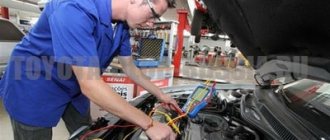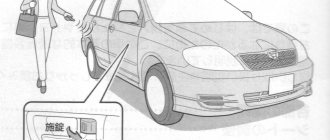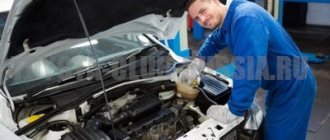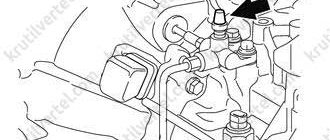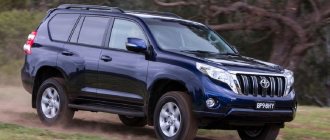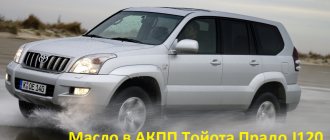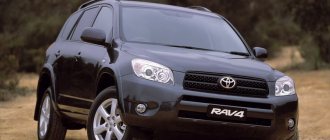The Land Cruiser 200 SUV is famous all over the world due to its aggressive design, luxurious interior and enormous cross-country ability. This is a universal car that confidently overcomes obstacles and is not afraid of the harsh Russian winter. Maintenance of the Toyota Land Cruiser 200 must be carried out on time in compliance with all manufacturer requirements. Wear of components occurs at an accelerated rate due to the fact that the owners do not attend maintenance on time and check the capabilities of the SUV when driving on soil, snow, sand, etc. All models from Toyota are famous for their high reliability, but only with careful operation and timely maintenance.
Fact: all Japanese cars are incredibly demanding, so the use of cheap fuel or oil, as well as low-quality spare parts, will quickly lead to wear and tear on components and assemblies. If you want to extend the life of your SUV, then undergo maintenance at certified Toyota services and always follow the maintenance deadlines.
Toyota Land Cruiser 200 Owner's Manual: Contents
Maintenance schedule Toyota Land Cruiser Prado (150)
Maintenance regulations for the Toyota Land Cruiser Prado (150).
Models: from 2009 to 2013 2.7 l, 163 hp, gasoline, manual transmission, all-wheel drive (4WD) - 2TR-FE (automatic transmission) 3.0 l, 173 hp, diesel, automatic transmission, all-wheel drive (4WD) - 1KD-FTV 4.0 l, 282 hp, petrol, automatic transmission, all-wheel drive (4WD) - 1GR-FE 4th generation 2017-... 2.7 l, 163 hp, petrol, manual transmission, all-wheel drive (4WD) - 2TR -FE 2.8 l, 177 hp, diesel, automatic transmission, all-wheel drive (4WD) - 1GD-FTV 4.0 l, 249 hp, gasoline, automatic transmission, all-wheel drive (4WD) - 1GR-FE
To quickly sign up for a service, simply fill out the “Registration for Maintenance” application.
Check and timely replacement:
- Pipes and connections of the cooling system, radiator - first check at 40,000 km, then 80,000 km, then every 20,000 km.
- Coolant - change first after 160,000 km, then every 80,000 km.
- Checking the fuel tank cap, fuel lines - first check at 40,000 km, then 80,000 km, then every 20,000 km.
- Airbags - first inspection 120 months from the date the vehicle was first registered.
First maintenance (10,000 km):
- Changing the engine oil
- Replacing the oil filter
- Checking the level of engine coolant, glass and headlight washers
- Checking vehicle components and assemblies for leaks and external damage
- Checking the brake system
- Checking drive shafts and drive shaft boots
- Checking suspension joints, joint boots, wheel bearing play
- Checking external and internal lighting devices, sound signal, windshield wipers and washers
Second service (20,000 km):
- Changing the engine oil
- Replacing the oil filter
- Checking the level of engine coolant, glass and headlight washers
- Checking vehicle components and assemblies for leaks and external damage
- Checking the exhaust system for leaks
- Checking the air filter
- Checking the brake system
- Checking the condition of the parking brake drums and shoes
- Steering: checking play, condition of boots, ease of rotation of the steering wheel
- Checking drive shafts and drive shaft boots
- Checking suspension joints, joint boots, wheel bearing play
- Checking external and internal lighting devices, sound signal, windshield wipers and washers
- Replacing the cabin filter
- Checking the operation of the air conditioning system and refrigerant level
Third service (30,000 km):
- Changing the engine oil
- Replacing the oil filter
- Checking the level of engine coolant, glass and headlight washers
- Checking vehicle components and assemblies for leaks and external damage
- Checking the brake system
- Replacing brake fluid
- Checking drive shafts and drive shaft boots
- Checking suspension joints, joint boots, wheel bearing play
- Checking the gear shift lever (for 6-speed manual transmission)
- Checking external and internal lighting devices, sound signal, windshield wipers and washers
Fourth maintenance (40,000 km):
- Changing the engine oil
- Replacing the oil filter
- Checking the level of engine coolant, glass and headlight washers
- Checking vehicle components and assemblies for leaks and external damage
- Checking the brake system
- Checking the exhaust system for leaks
- Steering: checking play, condition of boots, ease of rotation of the steering wheel
- Checking drive shafts and drive shaft boots
- Checking suspension joints, joint boots, wheel bearing play
- Checking the fluid of the Multidrive S
- Checking manual transmission oil
- Checking external and internal lighting devices, sound signal, windshield wipers and washers
- Replacing the cabin filter
- Checking the operation of the air conditioning system and refrigerant level
Fifth maintenance (50,000 km):
- Changing the engine oil
- Replacing the oil filter
- Checking the level of engine coolant, glass and headlight washers
- Checking vehicle components and assemblies for leaks and external damage
- Checking the brake system
- Checking drive shafts and drive shaft boots
- Checking suspension joints, joint boots, wheel bearing play
- Checking external and internal lighting devices, sound signal, windshield wipers and washers
- Checking the condition of the parking brake drums and shoes
Sixth maintenance (60,000 km):
- Changing the engine oil
- Replacing the oil filter
- Checking the level of engine coolant, glass and headlight washers
- Checking vehicle components and assemblies for leaks and external damage
- Checking the brake system
- Checking drive shafts and drive shaft boots
- Checking suspension joints, joint boots, wheel bearing play
- Checking the gear shift lever (for 6-speed manual transmission)
- Checking external and internal lighting devices, sound signal, windshield wipers and washers
- Replacing the cabin filter
- Checking the operation of the air conditioning system and refrigerant level
Seventh maintenance (70,000 km):
- Changing the engine oil
- Replacing the oil filter
- Checking the level of engine coolant, glass and headlight washers
- Checking vehicle components and assemblies for leaks and external damage
- Checking the brake system
- Checking drive shafts and drive shaft boots
- Checking suspension joints, joint boots, wheel bearing play
- Checking external and internal lighting devices, sound signal, windshield wipers and washers
Eighth maintenance (80,000 km):
- Changing the engine oil
- Replacing the oil filter
- Checking the level of engine coolant, glass and headlight washers
- Checking vehicle components and assemblies for leaks and external damage
- Checking the brake system
- Replacing the fuel filter
- Replacing the air filter
- Checking the fuel vapor adsorber
- Checking the condition of the parking brake drums and shoes
- Replacing brake fluid
- Steering: checking play, condition of boots, ease of rotation of the steering wheel
- Checking drive shafts and drive shaft boots
- Checking suspension joints, joint boots, wheel bearing play
- Checking the fluid of the Multidrive S
- Checking manual transmission oil
- Checking external and internal lighting devices, sound signal, windshield wipers and washers
- Replacing the cabin filter
- Checking the operation of the air conditioning system and refrigerant level
Ninth maintenance (90,000 km):
- Changing the engine oil
- Replacing the oil filter
- Checking the level of engine coolant, glass and headlight washers
- Checking vehicle components and assemblies for leaks and external damage
- Checking the brake system
- Checking drive shafts and drive shaft boots
- Checking suspension joints, joint boots, wheel bearing play
- Checking the gear shift lever (for 6-speed manual transmission)
- Checking external and internal lighting devices, sound signal, windshield wipers and washers
Tenth maintenance (100,000 km):
- Changing the engine oil
- Replacing the oil filter
- Checking the level of engine coolant, glass and headlight washers
- Checking vehicle components and assemblies for leaks and external damage
- Checking the brake system
- Checking the exhaust system for leaks
- Replacing spark plugs
- Cleaning the fuel system
- Checking the air filter
- Checking the condition of the parking brake drums and shoes
- Steering: checking play, condition of boots, ease of rotation of the steering wheel
- Checking drive shafts and drive shaft boots
- Checking suspension joints, joint boots, wheel bearing play
- Checking external and internal lighting devices, sound signal, windshield wipers and washers
- Replacing the cabin filter
- Checking the operation of the air conditioning system and refrigerant level
Toyota Land Cruiser 200: operating instructions for the security system
Front airbags, according to the Land Cruiser 200 operating manual, will work if the force of the collision exceeds the force of the car hitting a non-deformable wall at a speed of 20-30 km/h. However, this does not mean that the airbags will deploy in the event of any impact at the specified speed. The signal speed may be increased if the car hits an object that can be displaced or deformed, or if the hood is crushed under an obstacle, for example, under a truck trailer.
The Land Cruiser 200 operating instructions provide the following data: side curtains and airbags are activated during a side impact, with a force similar to that of a car weighing 1.5 tons, at a speed of 20-30 km per hour, as well as during a strong frontal impact .
Also, the side curtains are activated if the car overturns.
However, safety features can be activated not only in the event of a collision, but also in the following situations:
- Hitting a curb or other low obstacle.
- Falling into a large hole or flying over it.
- The car “jumps” from a step and lands hard.
- The side curtain protection may activate if the left or right row of wheels leaves the ground and the machine is at risk of rolling over.
- If the car hits an obstacle on its side during a skid.
What is a techdoc
Techdoc is a huge database of non-original spare parts with convenient sections for searching. The system is made for professionals who are trying to expand the choice of spare parts for the buyer. The program is available online and contains a large list of vehicle manufacturers. If you have the original unit number, you can see analogues from other brands that are not inferior in quality, but have a reduced cost. With the help of techdoc it is easy to find on the Toyota Land Cruiser Prado 150:
- spark plugs of famous brands;
- filter;
- suspension elements and so on.
Advantages of Techdoc:
- Large selection of non-original parts.
- Huge database of possible analogues.
- Ability to search for spare parts by original number.
- You can specify a vehicle and find spare parts for maintenance.
- Complete information is provided for servicing the machine, and there are manuals useful for amateurs.
- Availability of information that is not in the original catalogue.
- Suitable for car shops, services, disassemblies, which will allow you to instantly see prices and set the price for the buyer.
A positive aspect of the service is the ability to disassemble a part into individual spare parts; the system offers to select a separate unit to carry out repairs.
This is useful, for example, for a generator or starter.
Toyota Land Cruiser 200 manual: situations in which the airbags do not deploy
Situations in which the front airbags do not deploy:
- Side impact.
- Hit from behind.
- Car overturn.
Situations in which side airbags and curtains are not activated:
- A side impact that does not occur in the passenger compartment area.
- Side impact at an acute angle.
- Hit from behind.
The side curtains are activated if the car is turned over on its side and do not operate if it is turned over from the front or rear.
If children ride in the front seat in a car seat, turn off the airbag in front of them.
How to use it
Finding spare parts for Toyota Land Cruiser 200 in Techdoc is quite simple. The installed program includes more than 100 catalogs of auto parts that are suitable for various vehicles, regardless of make and model. To record you need:
- Use the installation file or disk, select the most powerful PC in the office. During installation, check the “Install as server” box.
- A new menu will open access to the folder where the TechDoc is mounted. The standard storage location is C:\TECDOC.
- From the main computers that will use the program, go over the network to the server.
- In the TechDoc folder, find the POD section, in which select the silentPoDLauncher.exe file.
- If everything is done correctly, there will be an icon for the program on the desktop.
The menu interface is Russian and intuitive. For further work, enter the number of the original part or perform a manual selection using the model and make of the car, the group of auto parts in which the required unit may be located.
